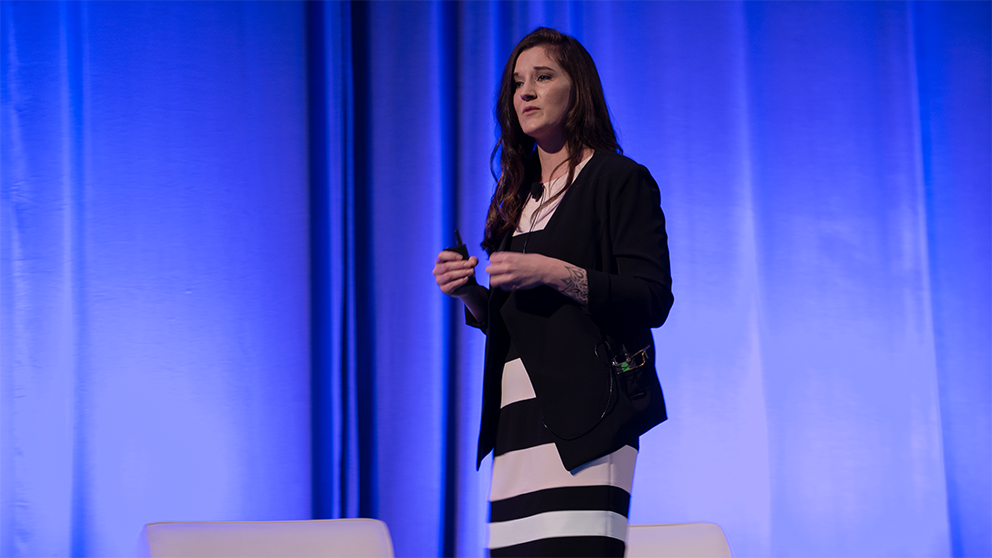
Cortney Lovell woke up in her beat-up hatchback car in rural upstate New York the morning of February 9, 2008. She was cold and confused. She hadn’t expected to wake up at all.
Lovell was 19 years old and had decided the night before to take the rest of her heroin and cocaine. Battling substance use disorder (SUD) and running from 27 different felony charges, she didn’t know what else to do.
“I was so hopeless, so full of despair,” said Lovell, now 30. “I had resigned myself to the idea that I would live the rest of my days and die addicted to opioids, and that was going to be it for me.”
But against all odds, Lovell lived. She began to drive, leaving the first tire tracks on a fresh bed of snow.
“For the first time in years, I had this open feeling,” Lovell said. “I thought, ‘Maybe I can have a blank slate now.’”
She drove to the only place she knew she could always go back to: home. In her parents’ kitchen, she was arrested and taken to a county jail, where she endured opioid withdrawal and was later able to thrive through a process of recovery with treatment and community support.
“We should not just be treating the active stages of addiction and withdrawal but should set up our treatment structures to correlate with the stages of recovery. We need to be supporting patients in their active use, and also supporting them during treatment and for years after.”
Cortney Lovell
Co-founder, Our Wellness Collective
Lovell told her story during a seminal workshop held just outside Washington, D.C., on May 9 and 10 that brought together leaders from 134 medical institutions and 15 federal agencies and associations to share effective strategies and discuss the challenges of educating current and future physicians on pain management and SUDs. Convened by the AAMC in collaboration with the Accreditation Council for Continuing Medical Education (ACCME), the Accreditation Council for Graduate Medical Education (ACGME), and the American Association of Colleges of Osteopathic Medicine (AACOM), the workshop was the first convening of medical educators across the continuum to focus on the opioid epidemic.
The statistics are startling: Deaths due to opioids increased 345% between 2001 and 2016. In 2017, opioids were responsible for 47,600 deaths, 35% of which involved a prescription drug. Approximately 20 million adults have an SUD, and 130 die every day from opioid overdose. During the course of the workshop, approximately 200 Americans will have died from an overdose, Alison Whelan, MD, AAMC’s chief medical education officer, told the 400 conference attendees.
The epidemic affects every state in the country and every socioeconomic group. “We talk about hot spots, but the fact is, the epidemic affects the entire United States,” Whelan said.
In many ways, Lovell seemed like she had it all: She was a three-sport varsity athlete and honors student from a loving home. But underneath, she was crumbling. She began suffering from a mood disorder in the eighth grade, and her predisposition for addiction created the perfect storm when her friends introduced her to drugs and alcohol.
“I had no idea when I started experimenting that I would turn on a switch that I would spend the next five years trying to turn off,” Lovell said.
Lovell represents just one side of the deadly epidemic. In 2017, Washington, D.C., saw 279 opioid-related deaths — and many of those were black men ages 50 to 60 years old, said Roger Mitchell Jr., MD, D.C.’s chief medical examiner. “The opioid crisis in urban centers — it is a construct of institutional and structural racism,” Mitchell said. “We need to have a conversation about pain medication and pain management. We need to have a conversation about access.”
Just as the problem is multifactorial, solutions to address it are necessarily so as well. Leaders from the Centers for Disease Control and Prevention (CDC), which helped fund the workshop, the Food and Drug Administration (FDA), the National Institute for Drug Abuse (NIDA), the Substance Abuse and Mental Health Services Administration (SAMHSA), and the National Institute of Neurological Disorders and Stroke (NINDS) spoke at the workshop about their agencies’ efforts to tackle the epidemic, as well as some of the challenges inherent in treating both pain and addiction.
“We talk about hot spots, but the fact is, the epidemic affects the entire United States.”
Alison Whelan, MD
AAMC
Just a decade ago, physicians were encouraged to prescribe opioids to address what was considered an undertreatment of pain, said Anne Schuchat, MD, CDC principal deputy director. “Many of us still do what we learned in medical school, but the world has changed a lot. A lot of our problem is where we thought we were doing the right thing and we probably were not.”
Other challenges identified by workshop participants included the lack of clear guidance on the safe prescribing not just of opioids but all controlled substances, the dearth of evidence-based behavioral approaches to pain management as well as the lack of reimbursement for these alternative approaches, and the personal biases of some clinicians toward treating those in chronic pain and those with SUD.
During breakout sessions throughout the conference, workshop participants shared best practices, including training physicians to prescribe buprenorphine or medication assisted treatment, and areas for improvement. Four academic institutions also were honored for their curricular innovations around pain management and SUDs.
The University of Massachusetts Medical School, the Warren Alpert School of Medicine at Brown University, the University of Michigan School of Medicine, and the Uniformed Services University of the Health Sciences were recognized at the workshop as recipients of the AAMC 2018 Curricular Innovation Awards.
But there is still work to be done. Academic medical institutions must focus on core treatment principles like collaboration and communication, said Lovell, and usher people with substance use disorder all the way through their recoveries.
“We should not just be treating the active stages of addiction and withdrawal but should set up our treatment structures to correlate with the stages of recovery,” Lovell said. “We need to be supporting patients in their active use, and also supporting them during treatment and for years after.”
The workshop was just the latest in a multiyear effort by the AAMC to assess the needs of and share information about the opioid epidemic with the medical education community. In 2019, the AAMC, with funding from the Samueli Foundation, will award up to five curricular challenge grants to schools and teaching hospitals to develop resources that increase faculty proficiency in pain management and SUD.
For more information, visit AAMC's Medical Education Initiative.
